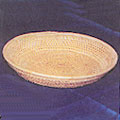Pata weaving of Chhattisgarh is symbolized by striking red or maroon color over a base white color. This style of weaving is practiced by a non-tribal community Paneka. Fabric made by Paneka community is consumed by Dhurva and Muria tribe for their daily and ceremonial use.
The Panekas believe that they are disciples of saint Kabir. The pit loom used for weaving is made from sangwan (teak) wood. Pata is the weaving of heavy, thick, unbleached, handspun cotton sari. The madder red is used in border which is processed from Al trees of Odisha and central India. The designs are woven in extra weft technique. Motifs depicting animals, Pilpilli (butterflies), chidi (birds), gacho (trees), huts, bows, arrows, flowers, pitchers, temples and lions are woven. Inspired by the ritual wall painting of Odisha, Kumbh motif is created by interlocking threads in the pallav (end piece) of the sari.
This short and narrow fabric is draped in a variety of styles by different tribes. The sundermani (sari) is worn by women whilw the onchapata (lower garment) and pheta (headwear) by men. Different pata’s are made to serve different purposes. Kosa woven pata is a silk cloth worn by pujari. There are also several other pata’s such as mangalgiriptata, khanduapata, kabripata etc.
Gallery
YOUR VIEWS
PRACTITIONERS: INDIA
Access 70,000+ practitioners in 2500+ crafts across India.
BIBLIOGRAPHY
10,000+ listings on arts, crafts, design, heritage, culture etc.
GLOSSARY
Rich and often unfamiliar vocabulary of crafts and textiles.
SHOP at India InCH
Needs to be written.






